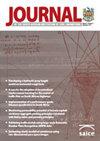利用日降雨量数据和以地理为中心的方法估算面积减少因子
IF 0.4
4区 工程技术
Q4 ENGINEERING, CIVIL
Journal of the South African Institution of Civil Engineering
Pub Date : 2020-01-01
DOI:10.17159/2309-8775/2020/V62N4A3
引用次数: 2
摘要
本文提出了基于日降雨量数据的以地理为中心和概率正确的面积减少因子(ARFs)的估计,以解释南非C5次排水区域集水区平均设计点降雨量和平均面积设计降雨量估计之间的独特关系,作为一个试点案例研究。所采用的方法是基于贝尔地理中心方法的改进版本。样本ARF值随流域面积、风暴持续时间和回归期的变化而变化,从而证实了其概率性。与目前在南非使用的以地理和风暴为中心的方法相比,导出的算法还提供了改进的ARF概率估计。在国家一级,预计该方法的实施和扩大将最终有助于改进南非流域一级的ARF估计。因此,改进的ARF估计也将导致改进的设计洪水估计。本文章由计算机程序翻译,如有差异,请以英文原文为准。
Estimation of areai reduction factors using daily rainfall data and a geographically centred approach
This paper presents the estimation of geographically centred and probabilistically correct areal reduction factors (ARFs) from daily rainfall data to explain the unique relationship between average design point rainfall and average areal design rainfall estimates at a catchment level in the C5 secondary drainage region in South Africa as a pilot case study. The methodology adopted is based on a modified version of Bell's geographically centred approach. The sample ARF values estimated varied with catchment area, storm duration and return period, hence confirming the probabilistic nature. The derived algorithms also provided improved probabilistic ARF estimates in comparison to the geographically and storm-centred methods currently used in South Africa. At a national level, it is envisaged that the implementation and expansion of the methodology will ultimately contribute towards improved ARF estimations at a catchment level in South Africa. Consequently, the improved ARF estimations will also result in improved design flood estimations.
求助全文
通过发布文献求助,成功后即可免费获取论文全文。
去求助
来源期刊
CiteScore
0.70
自引率
25.00%
发文量
19
审稿时长
>12 weeks
期刊介绍:
The Journal of the South African Institution of Civil Engineering publishes peer reviewed papers on all aspects of Civil Engineering relevant to Africa. It is an open access, ISI accredited journal, providing authoritative information not only on current developments, but also – through its back issues – giving access to data on established practices and the construction of existing infrastructure. It is published quarterly and is controlled by a Journal Editorial Panel.
The forerunner of the South African Institution of Civil Engineering was established in 1903 as a learned society aiming to develop technology and to share knowledge for the development of the day. The minutes of the proceedings of the then Cape Society of Civil Engineers mainly contained technical papers presented at the Society''s meetings. Since then, and throughout its long history, during which time it has undergone several name changes, the organisation has continued to publish technical papers in its monthly publication (magazine), until 1993 when it created a separate journal for the publication of technical papers.

 求助内容:
求助内容: 应助结果提醒方式:
应助结果提醒方式:


